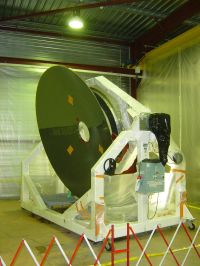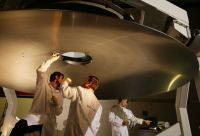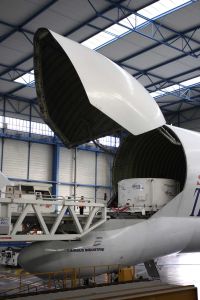Herschel Mirror on the Move
6 July 2004
The Herschel telescope primary mirror blank has now been machined to its final shape and thickness. After the machining was completed, the mirror blank was thoroughly tested and inspected to check the integrity of its construction. At the end of June, the mirror blank was transported by road and air from Toulouse, France to Turku, Finland, where it will be polished to create the optical surface. |
|
Primary mirror blank after machining, mounted on its ground handling system. |
The 3.5 m diameter primary mirror blank for the Herschel telescope was fabricated by brazing together twelve silicon carbide (SiC) segments. To provide mechanical stability both during the manufacturing of the segments and while the mirror blank was being assembled, temporary stiffening ribs were positioned on the internal surface of the segments, in addition to the external surface stiffeners that are part of the final mirror configuration. Once the assembly process was completed, the mirror blank was machined by grinding to remove the temporary stiffening ribs, reduce the thickness of the mirror shell to 3 mm and arrive at the correct shell profile ready for polishing. The machining process reduced the mass of the mirror blank from 720 kg to 240 kg. The mass of the completed telescope will be 315 kg.
 |
|
Machined mirror blank undergoing ultrasonic inspection of the brazed joints between its segments. |
The machined mirror blank was extensively inspected and tested. The integrity of the brazed joints between the petals was confirmed by ultrasonic inspection, pictured here. Then, the mirror blank was transported by road from the premises of Boostec (Bazet, near Tarbes, France), where it was manufactured, to the Toulouse (France) facility of EADS Astrium, the telescope Prime Contractor. There, the mirror blank underwent proof load testing, during which it was mounted on a vibration table and subjected to swept frequency sinusoidal vibrations. The completed telescope will undergo more extensive mechanical load testing, including shock and random vibrations, at a later stage.
 |
|
Mirror transport container being loaded into the Beluga. |
|
|
On 29 June, the mirror blank, having again been installed in its transport container, was loaded onto an Airbus
Upon arrival in Finland later that day, the mirror blank was delivered to the Opteon laboratory at the University of Turku's Tuorla Observatory, where it was unpacked from the transport container and mounted on the polishing table.
Starting from a post-machining surface error of 170 µm RMS, the polishing process will refine the parabolic reflector to achieve a surface error of 1.5 µm RMS and a surface roughness of less than 30 nm. The surface accuracy of the primary and secondary mirrors will be such that the completed telescope will have a total wavefront error of less than 6 µm RMS.

